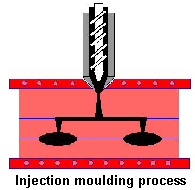Rubber-Lexicon
Injection moulding process (IM)
With injection moulding for the production of rubber moulded parts the rubber mixture is pre-heated in an injection moulding machine at first in a snail aggregate and plastified (80 – 100°C) and then injected through sprueing channels into the heated mould. Depending on the type of construction, a distinction is made between horizontal and vertical injection moulding machines. The injection process follows either through direct pushing of the snail in the cylinder or through the injection via a separate cylinder (injection pistons).
Compared to the compression moulding (CM) the IM process is the modern process for the production of rubber moulded parts. Through the plastification in the injection aggregate, compared to the CM process clearly reduced heating times are achieved. With the use of suitable handling technology for the removal of rubber moulded parts, also a fully automatic moulding process is possible.
The vulcanized elastomer material in the sprueing channels must be disposed of as vulcanization waste. Through the use of nozzle cold runners the waste amount can however be substantially reduced.
